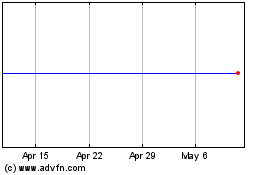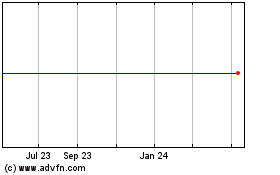2nd UPDATE: BP Abandons 'Top Kill' Attempt To Stem Oil Leak
May 29 2010 - 10:41PM
Dow Jones News
BP PLC (BP, BP.LN) has abandoned an attempt to plug a mile-deep
oil and natural-gas gusher in the U.S. Gulf of Mexico by injecting
thousands of barrels of drilling fluid and will now try a new
method to contain the flow of hydrocarbons.
"We have been unable to overcome the flow from the well," said
BP Chief Operating Officer Doug Suttles, in a press briefing. "We
now believe it is time to move on to the next of our options," he
said, adding it wasn't clear exactly why the procedure called a top
kill, started on Wednesday, failed to stem the flow of oil and gas.
The decision to give up on the top-kill attempt was made late
Saturday afternoon after consultation with U.S. Secretary of Energy
Steven Chu and Interior Secretary Ken Salazar.
Engineers will now try to contain the flow of oil from the leak
with a so-called lower marine riser package, or LMRP, cap. This
operation would involve removing a broken drilling pipe, or riser,
that lies atop the failed blowout preventer and cap the valve with
a siphon that will take the oil to the surface. Suttles said the
LMRP-cap procedure would take four to seven days. The LMRP cap is a
newly made version of a type of device referred to as a top
hat.
"The next thing to do is to capture all of the flow or as much
of the flow as we can," he said, adding BP "has a lot of
confidence" in the LMRP cap, but couldn't guarantee success. "We
believe the LMRP cap has the potential to capture the great
majority of [the leaking oil]," if it works. Suttles declined to
give a percentage probability that the new containment effort would
succeed, noting that nothing like this had been attempted at 5,000
feet below the surface of the sea. BP had previously said it gave
the now-failed top-kill procedure a 60%-70% chance of success.
"Based on what we know now, we believe the containment cap is
the most effective way to minimize the impact of the oil leak on
the Gulf ecosystem and the people of the region," said BP Chief
Executive Tony Hayward, in an emailed statement. "We'll continue to
refine the effort, to create the most stable and effective
containment process possible."
The failed top-kill effort followed several frustrated attempts
to activate the broken valve known as a blowout preventer and
install containment domes above the leaking well, which is
estimated to be releasing between 12,000 and 19,000 barrels a day
into the Gulf. The spill, which originated more than a month ago,
when Transocean Ltd.'s (RIG) Deepwater Horizon rig blew up and
sank, has officially become the worst in U.S. history, surpassing
the 1989 Exxon Valdez disaster.
Each failed attempt has sparked more intense criticism of BP,
which has been lambasted not only for its failure to plug the
gusher but also for not keeping the public fully abreast of its
actions. BP's shares have lost about 30% since the disaster on
April 20, and the company faces the prospect of large costs to
contain the spill and remediate the damage, as well as litigation.
The company, along with the rest of the oil industry, will also
have to contend with tighter regulation on deepwater drilling.
U.S. President Barrack Obama, who on Thursday announced new
measures to curtail offshore drilling, late Saturday expressed
outrage at the duration of the spill and noted that the LMRP cap is
risky. "That is why it was not activated until other methods had
been exhausted. It will be difficult and will take several
days."
With this latest plan, BP will face the same challenges as it
has since the rig sank: working under enormous pressure at extreme
temperatures in the midst of large amounts of gushing oil.
The planned maneuver is in some ways more complex than the top
hat, the containment structure that BP tried earlier this month
without success, experts say. The cap is much smaller and must be
positioned exactly on top of the blowout preventer.
In the best case scenario, the cap will funnel the oil up to the
drilling boat, but won't prevent it from rushing out of the well.
By cutting the bent pipe, which may be partially blocking the flow,
BP could temporarily increase the amount of oil that's coming
out.
"Anytime that they get in and start moving things around, you
potentially raise the risk of making it worse before you make it
better," said Dan Pickering, a petroleum engineer who does analysis
at Tudor, Pickering, Holt & Co.
If the LMRP cap containment attempt fails, Suttles said earlier
Saturday that the next step would be to try and place another
blow-out preventer atop the broken one.
Seabed drilling of one of two relief wells that will ultimately
allow final plugging of the leak is about halfway finished, Suttles
said, though he added the drilling gets more difficult the deeper
the bit gets. He said early August remains the best estimate for
when drilling of the relief well will be finished.
Obama said that authorities "will continue to pursue any and all
responsible means of stopping this leak until the completion of the
two relief wells currently being drilled."
Suttles also said earlier at a press conference at Fourchon
Beach, La., that the oil-spill recovery operations had cost $940
million to date. He added that BP would reimburse the federal
government for the more than $100 million it supplied.
"Everything to do with cleaning this thing up is our
responsibility," he said.
-By Mark Long, Dow Jones Newswires; 212-416-2145;
mark.long@dowjones.com
(Mark Peters, Siobhan Hughes, Ana Campoy and Angel Gonzalez
contributed to this article.)
Cooper Cameron (NYSE:CAM)
Historical Stock Chart
From Jun 2024 to Jul 2024

Cooper Cameron (NYSE:CAM)
Historical Stock Chart
From Jul 2023 to Jul 2024
